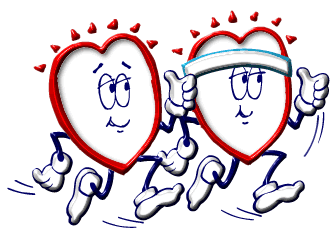By: Allison Hoit and Kelly Bonner
The Heart
You’ve probably heard someone talk about being in love or having his or her heart broken. You also might have experienced the feeling of your heart pumping while playing with friends or at a sport practice. Maybe you have heard about a grandparent having a heart attack or having heart surgery. But what exactly is a heart?
also might have experienced the feeling of your heart pumping while playing with friends or at a sport practice. Maybe you have heard about a grandparent having a heart attack or having heart surgery. But what exactly is a heart?
Did you know your heart is a muscle just like the muscles in your arms or legs? Exercise makes the muscles in your body stronger, and it can also make your heart stronger! Take your hand and make it into a fist; that’s the size of your actual heart.  Your heart is located under your ribs, slightly to the left side of your chest. The heart plays a very important role in the functioning of your body by pumping blood throughout every time it beats. The blood pumped by your heart carries important oxygen and nutrients that your body needs. Once it delivers all the nutrients throughout your body, its return trip picks up all the unwanted toxins, such as carbon dioxide, to release while you are breathing.
Your heart is located under your ribs, slightly to the left side of your chest. The heart plays a very important role in the functioning of your body by pumping blood throughout every time it beats. The blood pumped by your heart carries important oxygen and nutrients that your body needs. Once it delivers all the nutrients throughout your body, its return trip picks up all the unwanted toxins, such as carbon dioxide, to release while you are breathing.
Your heart is divided into four chambers with valves that allow the blood to pump through. What you hear when listening to someone’s heartbeat is the sound of the heart valves opening and closing. When you listen closely to the heart or take someone’s pulse you can tell how quickly or slowly his or her heart is beating. This is also known as the heart rate.
Let’s Play a Game
Ask an adult to help you take your heart rate (also known as your pulse) to see how quickly or slowly your heart is beating. There are two places where you can feel your heart beat the best to obtain a pulse; your wrist and your neck. To obtain your pulse at the wrist, place two fingers on the inside of your wrist below the thumb. To obtain your pulse at the neck, locate an artery on the left-hand side, underneath your jaw. Pick which location is the easiest to feel your pulse and count each beat for a 30-second period. At the end of the 30 seconds, double the number and that is your resting heart rate. Now that you know your resting heart rate, let’s see how it changes after you have been moving. Swing your arms really fast or jump up and down for two minutes then follow the same steps to determine your heat rate. Is it faster?
Exercising Your Heart
The more you move, the faster your heart beats. To exercise your heart and make it healthier and stronger, complete 60 minutes of physical activity each day! As you have just learned, your heart is a very important part of your body. Make sure to exercise it more often instead of sitting during television shows or computer games.
Let’s take a quiz!
Put these activities in order of which will give you the highest to lowest heart rate:
A. Playing on the computer
B. Playing chase outside
C. Playing a game on Wii
The Answer is B. C. A.
Did you get it right?
